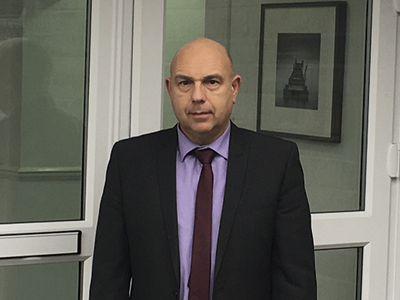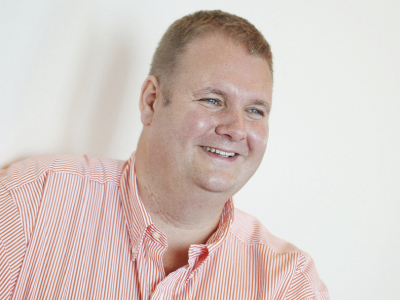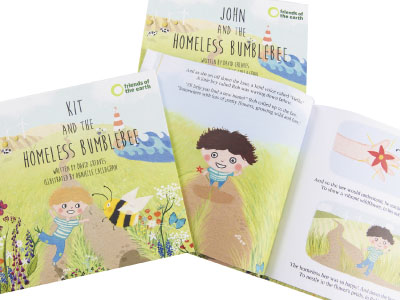At the 2016 Digital Printer Awards one entry created quite a buzz. Taking away four trophies, The Homeless Bumblebee by Harrier Print left its competition feeling stung.
Beautifully conceived, cleverly funded, well produced and met the aims of a demanding client and the intended audience, while showing all that is innovative about digital printing,’ is how the Digital Printer Awards’ judges described the piece for its win in the Supreme award. Other awards scooped up on the day included Environment, Innovation and Multi-channel communication. There is more to this than just a personalised children’s book.
For those who are not familiar with the project, the Homeless Bumblebee allows the customer to change the name and appearance of the main character in the book. It comes in either hardcover or paperback, delivered for free and all profits go to Friends of the Earth.
Darryl Allen, Harrier Print’s commercial manager, explained, ‘The Homeless Bumblebee – we took the concept to Friends of the Earth and RNLI. Friends of the Earth used its contacts to source the writers and illustrators while we produced and project managed. We have a commercial team at Harrier that is 18 strong – a mix of sales, marketing and admin and they are dedicated to the commercial print business.’

Darryl Allen, Harrier Print’s commercial manager
The company has produced 100,000 units in three years and is working on two new potential projects for 2017, by developing a fully variable avatar builder, which means it can create a more engaging personalised book.
The company is in essence a photo processing firm owned by the same family that owns US outfit District Photo. Harrier’s own brands for photo products are Truprint (some readers may remember the 80s TV adverts and receiving envelopes through the door and inside magazines for posting films off to be developed) and SnapFish. Originally developed by Harrier it was sold to HP and then when it no longer fitted with HP’s core strategy the company bought it back again in 2015. Currently Harrier is growing the commercial side of the business, which at the moment is mainly trade print but it is looking at selling more online.
Mr Allen said, ‘The feedback I get from the market is that with other online trade offerings you get what you pay for, and a lot of the prices at the moment account for the fact that there is no customer service or support. The customers are left to be their own boss. We are adamant that even in a trade model it remains to be about customer service and the personal touch. We can take out a lot of cost with the automated workflow but you still need the service and support though, which can’t be automated.’
Harrier Print is the largest single HP Indigo site in the UK with nine presses, all SRA3 – a mix of of 5000 series and 7000 series machines, including the latest 7900, using them for short and medium run work. The company’s finishing options includes both PUR and casebound, and it also has a Kolbus KM 200 fully automated binder.
Source of wisdom
While at drupa last year Julian Marsh, Harrier’s business consultant was approached by Dion Weisler, president & CEO at HP, who asked him, ‘How can I help our customers?’

Julian Marsh, Harrier Print’s business consultant
Mr Marsh replied, ‘Connect them to the people who spend money. Print as a whole is poor at promoting itself, which is where Dscoop is good. If HP can introduce me to brands then that is manna from heaven. District Photo and Harrier – we’ve got great manufacturing with the UK site here, two in the US and one in Melbourne, Australia to cover the Asia Pacific region. The photo market is a high added value sector but the biggest challenge is the seasonality, which is getting worse if anything. I call it the Amazon effect. Everyone now thinks that they can wait until the 22 December to order and expect it to arrive by Christmas, people think in a different way now to how they did 10 years ago. Photo is growing – it’s up 10% in terms of revenue and more than that in terms of volume. We have to be able to produce the required volume in shorter and shorter time frame, but then during the rest of the year it is an under utilised resource.’
Mr Allen’s project over the next five years is to grow commercial turnover. Turnover for 2016 was £30 million, of that 15% was commercial from a standing start of zero four years ago. ‘We spent the first year formulating the plan and since then it has been 20-30% year on year growth. Currently that is coming from requests for more of the same. We still get discovered by customers who didn’t know that we existed. Every month someone comes across us and says we are print’s best kept secret. I want us to be print’s worst kept secret. These customers can be worth a lot of money.’
Clash of cultures
Talking about the company’s B2 capabilities Mr Allen explained, ‘We have the [HP Indigo] 10000 in our sister firm in the US, overall we have 50 Indigos worldwide, but that’s not relevant for the UK market right now. The commercial print model has now been proven in the UK. We hothoused it here. Now I’m off to the US to roll it out there starting from the East Coast.’
However, there are many challenges that come with integrating commercial work with photo, he continued. ‘There’s a big difference in culture and in product range. Photo products, although the images are different for every customer, the products themselves are very standardised. They can be highly controlled using standard operating procedures. Culture is a big thing. And then there’s the seasonality to think about. When it gets really busy everyone from the office gets on the shop floor. Commercial print is very different; someone here asked me if it is always chaos, I said yes. What matters is how you handle it.
‘We have two growth models for commercial print. One is to do more of the same with additional efficiency and some online tools. The other is to set up ecommerce print sites. Our USP is being geared up for short runs. We have been testing some sites in the course of the past year and have done proof of concept. A lot is based on the same workflow we use for photobooks.’
Mr Marsh added, ‘We could just grow our sales quicker by attempting to offer everything but the problem is it would cost twice as much to deliver and wouldn’t produce a profit. My hack is to get rid of poor customers. The poor payers and the obnoxious. You will drop turnover but it will increase margin. You need to look at the value of the customer. In B2C it can be tens of pounds per year and you can accept a bit of attrition, so the effort goes into the brand. It’s different in B2B. An order for business cards may only be worth £30 but the importance of them getting to the right place at the right time may be worth thousands to the customer. It may also be part of a £100,000 per year account.’





